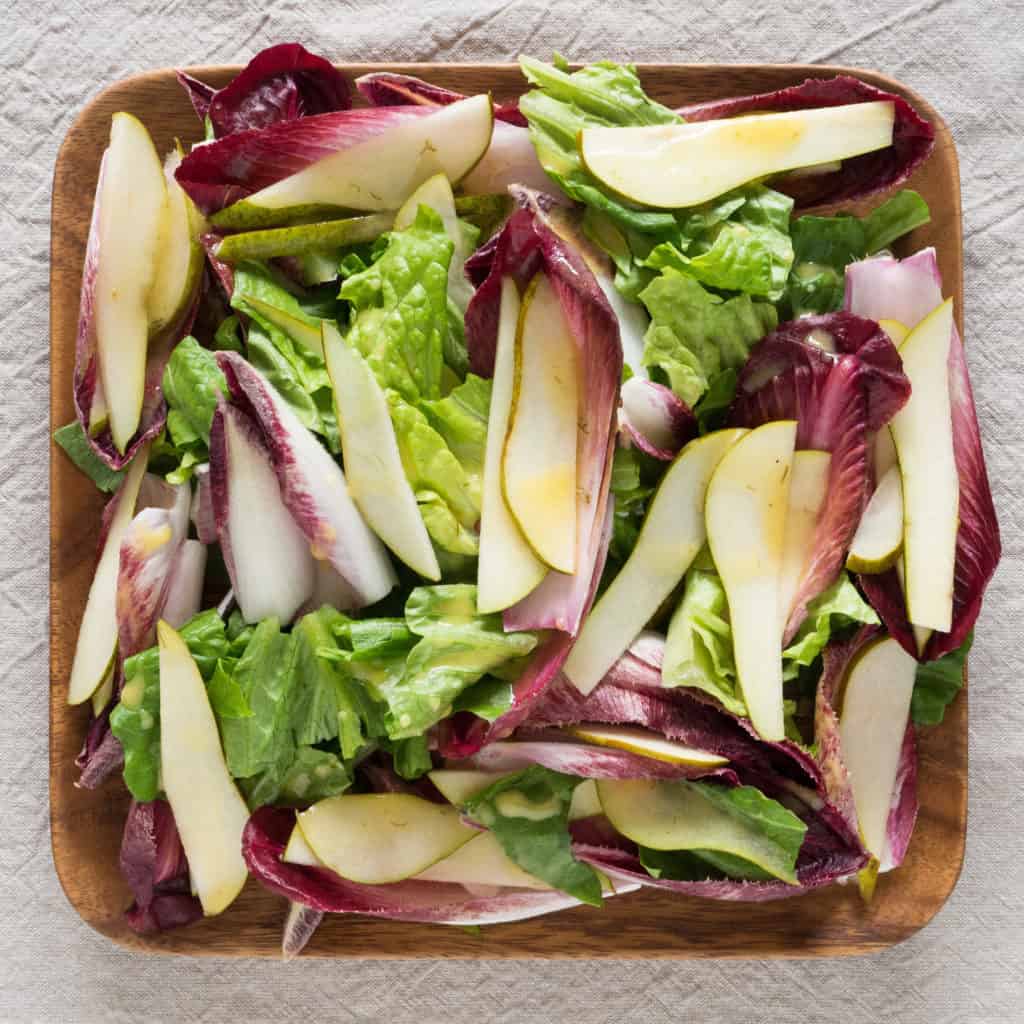
Summertime Endive Salad with Pears and Almonds is a pretty sophisticated salad that make me feel like a grown-up. Endive (or chicory) is a little bitter but, like so many bitter tasting foods, addictive. The bitterness of the chicory works so well with the sweetness of the cos, pear and almond and the textures all work so well together. Do not be afraid of the bitterness combined with the sweetness of the pears and almonds it is a wonderful salad.
Endive Salad with Pears and Almonds is super quick and easy to make.
You can find the full Endive Salad with Pears and Almonds here.
Endive Salad with Pears and Almonds is perfect for lunch, light dinner or as a starter for a special meal. Serve with Watercress Soup for a substantial lunch.
Endive is also known as chicory it is crunchy and slightly bitter and great in salads as it does not wilt with the dressing. You can get endive/ chicory in most supermarkets and local markets.
Preparation
Difficulty easy
Preparation time 15 minutes
Cooking time 0 minutes
You can find the full Endive Salad with Pears and Almonds here.
Allergens
Endive Salad with Pears and Almonds is gluten-free and vegan as well as…
Celery free
Coconut free
Garlic free
Lupin free
Nightshade free
Onion free
Peanut free
Sesame free
Soya free
Tree nut free.
About
Endive aka chicory, cichorium intybus is a woody, perennial herbaceous plant of the dandelion family asteraceae, usually with bright blue flowers, rarely white or pink. Lots of varieties are cultivated for salad leaves or roots. Root can be baked, ground, and used as a coffee substitute and additive (Mellow Birds anyone?). Chicory is also grown as a forage crop for livestock. It lives as a wild plant on roadsides in Europe (where it is native). Chicory is now common in North America, China, and Australia, where it has become widely naturalised. ‘Chicory’ is also the common name in the United States for curly endive (cichorium endivia) – these two (closely related) species are often confused.
Wild chicory leaves have a bitter taste. Their bitterness is part of their appeal and chiory/ endive is enjoying across Europe. In Ligurian cuisine, wild chicory leaves are an ingredient of preboggion and in Greek cuisine of horta, in Apulia wild chicory leaves are combined with fava bean puree in the traditional local dish fave e cicorie selvatiche. in Albania, the leaves are used as a spinach substitute, mainly served simmered and marinated in olive oil, or as ingredient for fillings of byrek.
Chicory is cultivated for its leaves and its roots and usually eaten raw as salad leaves. Cultivated chicory is generally divided into three types, of which there are many varieties: radicchio, sugarloaf and Belgian endive.
Radicchio usually has variegated red or red/ green leaves. It has a bitter and spicy taste, which mellows when it is grilled or roasted. It can also be used to add colour and zest to salads. Radicchio is commonly used in Italy and Greece.
Sugarloaf looks similar to cos lettuce, with tightly packed leaves.
Belgian endive is known in Dutch as witloof or witlof (“white leaf”), endive or (very rarely) witloof in the United States, indivia in Italy, endivias in Spain, chicory in the UK, as witlof in Australia, endive in France, and chicon in parts of northern France, in Wallonia and (in French) in Luxembourg. Belgian endive has a small head of cream-coloured, bitter leaves. It is grown in the absence of sunlight to prevent the leaves from turning green and opening up. The plant has to be kept just below the soil surface as it grows, only showing the very tip of the leaves. It is often sold wrapped in blue paper to protect it from light, so to preserve its pale colour and delicate flavour. The smooth, creamy white leaves may be served stuffed, baked, boiled, cut and cooked in a milk sauce, or simply cut raw. The tender leaves are slightly bitter; the whiter the leaf, the less bitter the taste. The harder inner part of the stem at the bottom of the head should be cut out before cooking to prevent bitterness.
Although leaf chicory is often called “endive”, true endive (cichorium endivia) is a different species in the genus and should not be confused with Belgian endive.
Having pondered all of this I am now not certain of the difference between endive and chicory or that I did not make chicory salad…